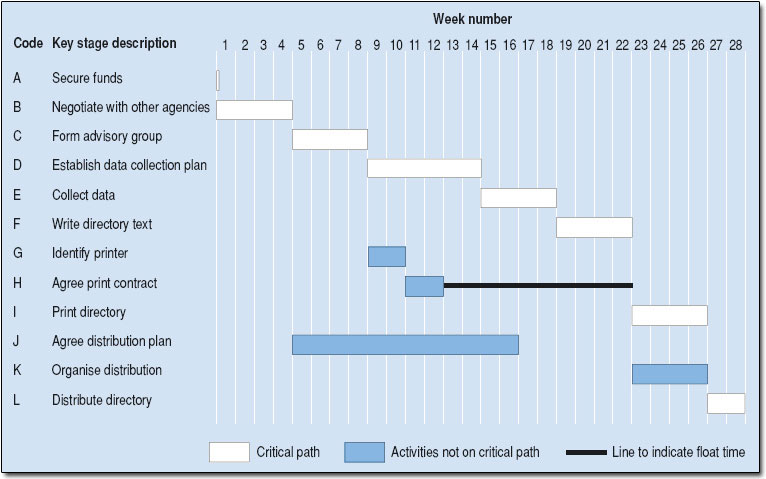3.7. Managing the Schedule
The Gantt Chart
A Gantt chart is a type of bar chart developed by Henry Gantt that illustrates a project schedule. Gantt charts are easy to read and are commonly used to display scheduled activities. These charts display the start and finish dates of the terminal elements and summary elements of a project. Terminal elements and summary elements comprise the work breakdown structure of the project. Some Gantt charts also show the dependency relationships (i.e., precedence network) between activities.
Gantt charts show all the key stages of a project and their duration as a bar chart, with the time scale across the top. The key stages are placed on the bar chart in sequence, starting in the top left corner and ending in the bottom right corner (Figure 3.2). A Gantt chart can be drawn quickly and easily and is often the first tool a project manager uses to provide a rough estimate of the time that it will take to complete the key tasks. Sometimes, it is useful to start with the target deadline for completion of the whole project because it is soon apparent if the time scale is too short or unnecessarily long. Thus, the detailed Gantt chart is usually constructed after the main objectives have been determined.

Milestones
As an Office Administrator, it’s helpful to understand the concept of project milestones. Milestones are key points in a project that help you stay on track and measure progress. They serve as high-level guides and are useful for communicating with stakeholders.
What are Milestones?
Milestones mark significant points in a project, such as:
- The start of important phases of work
- The end of important phases of work
- Deadlines for specific tasks
- Important decision points
Using Milestones
Milestones help you focus on the big picture and avoid getting lost in details. You can use pull planning to identify milestones and the critical path to ensure they are achievable. This helps you stay realistic about your project’s timeline.
Communication Tool
Milestones are especially useful for communicating the project’s health to stakeholders. A project schedule that includes only milestones gives a quick overview of where things stand. Reporting on milestones in the project’s dashboard provides an at-a-glance update for everyone involved.
“5.6. Managing the Schedule” from Essentials of Project Management by Adam Farag is licensed under a Creative Commons Attribution-NonCommercial-ShareAlike 4.0 International License, except where otherwise noted.

